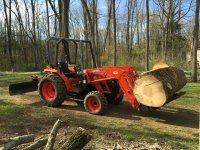Nikko,
I recently posted about the massey gc1715 as a lawn mowing machine. Now I'll talk about it as a tractor.
I have a long large concrete driveway with a considerable slope to it. I also have a front patio and rear patio of concrete and about 125 feet of 5 foot concrete sidewalk . . and we get wintet drifting too. So the GC will be using its bucket and/or bucket and snow edge often. And a lawn tractor will be equipped with a snowblower as well. My desire is to keep the fel on all winter . . so no $4500 snowblower for the gc1715. Too many snows will be bucket and snow edge. (Plow is too hard on concrete).
Then there is the brochure. Can you actually tell how much wdight the fel can lift? I can't. So on two different days I actually measured.
1st time I previously wrote about and it was 864 pounds of actual concrete I moved on pallet forked effort.
But I did it again yesterday in very controlled conditions.
Fel minus bucket.
Add 77 lbs for the quick attach
Add 115 lbs for the forks
Add 26 pounds for a cheap pallet
Add 63 concrete edgers scaled at 15.3 pounds per piece (963.9 lbs. Of concrete).
At 3100 rpm I was able to pick it up and move it 50 feet and set it back down. But then after a slight drizzle and a 10 minute rest . . I was not able to re-pick it up to take to destination . . so I removed 2 then 2 and finally 2 more edgers then making it a total of 57 edgers (872.1 pounds)
A dl95 loader on my gc1715 at 3150 rpm lifted and transported 200 feet up and down an incline the following
77 lbs + 115 lbs + 26 lbs + 872.1 pounds of payload. Total weight = 1090.1 lbs. Plus some rain water and 2 earth worms

I'd say with a mini grapple I'll be able to haul a good sized log or a biiig biiig bucket of rock

Don't you agree?
Also . . Consider the 3 pt carrying capacity is even larger. Lastly there's another type of grapple that is made for the same quick attach unit. It is a "vertical grapple" capable of grabbing water heaters or tree trunks and picking them out of the ground. That doesn't mean eight inch diameter trees . . But certainly 3 or 4 inch diameter rooted trees.
A good scut . . is capable of tractor performance . . over and over again. Its not a baby tractor . . at least not when the fel can produce what my measured weights show.
Now a gc1705 would be a smaller number because it us 2.5 horses smaller. At 2600 rpm I couldn't lift thw same as I could at 3000 or 3150 rpm. The GC1715 cost me $1200 plus tax more than the gc1705. For that difference I got superior seat with added spring suspension comfort and better fit of seat. I got a rear light. I got more lifting power and mire mud and rear pto power . . And kept all the advantages of a great lawn cutting unit and moving, digging, wood handling tractor too.
And even with the quick attach, forks, and future grapple and remote and all sales tax and snow edge and tire loading I will be less than $18,500 and insurance for 5 years and have 3.49% loan interest rate.
Thats everything nikko . . Everything
Now I'll sit back and listen as everyonr else says you need bigger bigger bigger Nikko. And your decision is your own . . I simply presented my needs and slopes and etc. Etc. And why I chosr the way I did. Your decision is up to your needs.

